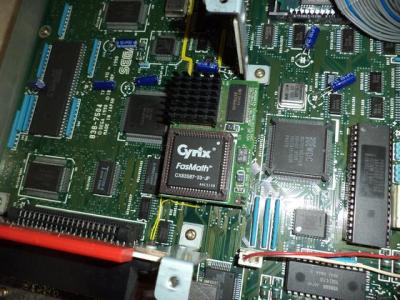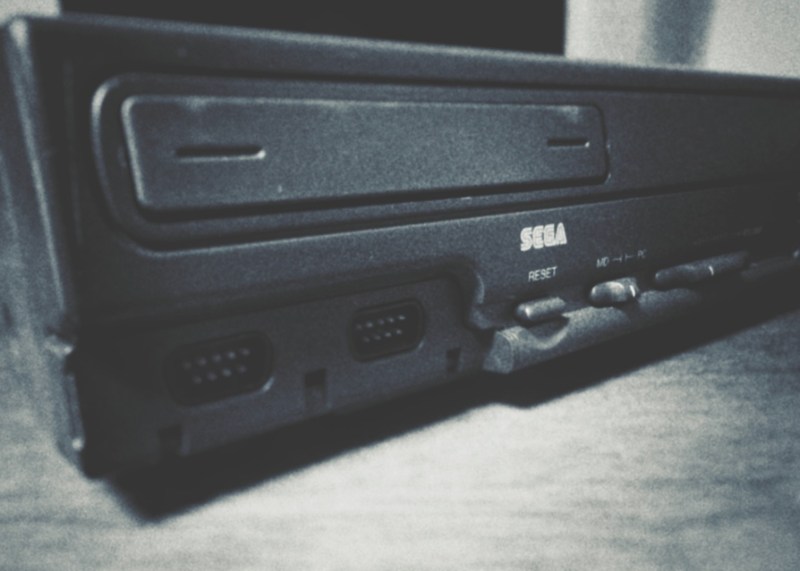During the 80s and 90s it seemed like Japan got all the good stuff when it came to videogames. In the US there were consoles called the NES, the TurboGrafx-16, and the Genesis. While in Japan they had cooler names like: the Famicom, the PC Engine, and the Mega Drive. The latter was incorporated into a plethora of different form factors, including the little known IBM PC/Mega Drive combo known as the Sega Teradrive. Finding a rare Japanese 1990s PC stateside is a feat in and of itself, and thanks to an electronics hobbyist named [Ronnie] there is at least one Teradrive out there still running strong thanks to an upgraded CPU mod.

In theory, the Sega Teradrive was a dream-machine; combining the utility of an IBM PC with the fun of a Sega Mega Drive. The dual functionality extended to the video modes where both VGA and composite video were supported. However, the reality was that the final design was less than desirable. The Teradrive shipped in 1991 with an Intel 80286, 16-bit processor which was already two processor generations behind at the time. The meager 10Mhz clock speed was on the lower end of the performance spectrum which meant that many DOS titles ran poorly…or not at all.
Not satisfied with those specs, [Ronnie] modded his Teradrive with an adapter board containing an Intel 80486 processor clocked at 66Mhz. The upgrade, accompanied with a complete re-cap of the motherboard, brings the IBM PC to 486DX status. This opened up a few new possibilities including the Thundercats Demo in the video below:
[via RetroRGB]
















Had to comment but I love it when someone slips Thundercats in unrelated subject like the video above
Thundercats, HO!
Why not an Am5x86-P75?
A worthy choice I presume, but I think Sega Teradrive just has a certain “ring” to it.
Well I specifying why they didn’t choose a better CPU? The AMD Am5x86-P75 was a super charged 486 which was almost inline with a Pentium @ 75mhz (Integer stuff was a little faster, but the FPU wasn’t).
I suspect the motherboard is the limiting factor. An Am5x86 goes in a 486 motherboard while this thing is a 286 motherboard. Besides the Cyrix Fast Math FPU there probably helped make up the difference.
“Besides the Cyrix Fast Math FPU there probably helped make up the difference.”
Not for most software. Very few things supported math co-processors back in the day.
Yeah, I saw that Cyrix in there and am still wiping vomit from my screen. They should only be used to balance wobbly tables, like a sugar packet.
BS, Cyrix made an excellent line of 287/387/487 coprocessors (YES, they made external 486 coprocessor – Cx487S). Cyrix FasMaths were fastest on the market. They also made solid 386 upgrade chips with 486 instruction set (486DLC can actually play Doom with bearable framerate!) and some of the fastest and cheapest proper 486 processors. Their infamy started with Quake being hand optimized for Intel pipelined FPU, Cyrix 6×86 still used Cx487 design FPU and couldnt keep up, heat didnt help either.
But Evergreen ‘Rev to 486’ is build around IBM 486SLC2 66MHz. Its IBMs internal design based on licensed Intel i486, an has nothing in common with Cyrix Cy486SLC. What you saw was merely a Cyrix coprocessor, something useless in Socket 3 era anyway.
Yeah, I know what I saw and what I saw on the bench as a lackey back then. You are entitled to your opinion, but I just saw way to many problems with Cyrix procs back in the day mainly their 586 chunks. The cheapo sorta pentium. I am sure there are things they did better like you say with the previous classes of procs, but there is something to be said for adhering to standards in a way that everything doesn’t require workarounds for basic functionality. It seems like we have had opposing opinions on the Cyrix before iirc anyway.
their “586” (Cx5x86) were just fast 486 equivalents, not Pentium, nothing wrong with them. Cyrix started sucking on socket 7, 6×86 was the crappy one.
My main point is what you are looking here in Evergreen ‘Rev to 486’ is IBM processor :). IBM build their own, by modifying licensed Intel layout.
I was reading somewhere online that at least the MS compiler’s FPU emulation routines would overwrite the calling function call with the equivalent x87 code and nops if it detected the hardware was available. So there might have been more software that used it, at least a little, than you’d expect.
I remembering upgrading to the 486DX because it had a math coprocessor built-in and it was needed for some physics stuff for Falcon 3.0. Not sure what other games had the capability to utilise it but I’m sure if it was built in to the DX and every processor since it was utilised for Floating Point calculations
The first computer I owned was a SEGA SC3000H – I absolutely love it.
Sega TeraDrive
In the UK we had the Amstrad Mega PC. If I remember correctly, it was a marketing flop due to insanely high prices and already outdated spec when it launched.
https://en.wikipedia.org/wiki/Amstrad_Mega_PC
Good luck finding one of those now.
The insanity didn’t stop there. Sky almost did a STB with a Dreamcast built in!
> During the 80s and 90s it seemed like Japan got all the good stuff when it came to videogames.
Over here in Germany it was hell for console gamers in the 80s and early 90s.
Japan got the cool stuff, you Yanks got most of the cool stuff and here in Germany we got what the garbage truck left behind.
Yeah … in 80s and early 90s in Poland we only got drinking games and stuff that what was stolen from garbage truck in Germany.
B^)
TI made some 486 CPUs pin compatible with PLCC 80286. They were intended to use old 286 chipsets to build $500 or cheaper PCs. The BIOSes for those just needed updates for the on chip cache and whatever integrated peripherals were included, which 286 boxes rarely, if ever, had.
Didn’t take long for various companies to market the CPUs as a direct drop in replacement to turn most any old box with a PLCC 286 into a clock doubled 486 SX. To get the full effect required software to enable the on chip L1 cache, which made the motherboard cache L2. Leveling up a 16Mhz 286 to 32Mhz would’ve been pretty good. Any slower than 12Mhz wouldn’t have been worth it. The vast majority of 286 systems I encountered were 12Mhz. I don’t recall ever seeing a 16Mhz 286 in the wild.
The real reason time machines can never exist…
Anyone geeky enough to invent one would immediately take all the outdated kit they have lying around and gift it to their past selves in a time when it was still top of the line or better. Then their past self would be so busy playing with new toys that the time machine would never get invented causing a paradox and destroying the universe.
I just checked FleaBay. I didn’t expect to find any. There are 3. I see what they are going for. I don’t think I would mod one if I had it now, I’d just sell!
But.. the mod is cool. I’m glad he’s done it and is showing us. I am wondering.. any plans on fixing the date? I assume some y2k fix will be required.
The reason you wouldn’t use a blazing fast Am5x86-133 in a 286 upgrade is because it’s completely pointless.
You’re hobbling a full 32 bit CPU onto a 16 bit data bus and 24 bit address bus. To make things worse, the 286 uses a multiplexed bus, where the upper part of the address bus is multiplexed onto the data bus, slowing things way down. Coupled with no motherboard cache and high latency page mode DRAM, high speed CPUs are completely crippled. You can enable the internal CPU cache for a small boost in performance, but that depends on software solutions that may or may not work or be stable.
Don’t get me wrong, you would see a performance gain, but it would be very minimal. The only real benefit to having a 386 or 486 upgrade for a 286 is to be able to run protected mode applications and benefit from the 386/486 instruction sets. While the 286 had protected mode, it was not the same protected mode introduced with the ubiquitous 386. You couldn’t escape 286 protected mode without rebooting (or using ugly hacky code), and 286 protected mode was 24 bit, not 32 bit.
>their “586” (Cx5x86) were just fast 486 equivalents, not Pentium, nothing wrong with them.
Incorrect. The Cx5x86 was a cut down early Cx6x86 core modified to work on the 486 bus. It had a lot more in common with the Pentium than it did with the 486. It was similar to what Intel did later with the Pentium Overdrive that hobbled a Pentium core onto the 486 bus.
There were also quite a few things wrong with Cyrix’s 5×86, which is why most of its advanced features that were promised by Cyrix were disabled in production silicon. There are tools available to re-enable these features, but it’s entirely up to silicon lottery and which die revision you have as to whether your CPU will be at all stable with them enabled. It wasn’t until some of the later core die revisions that some of these features were “mostly” fixed, but they still were never enabled in production silicon.